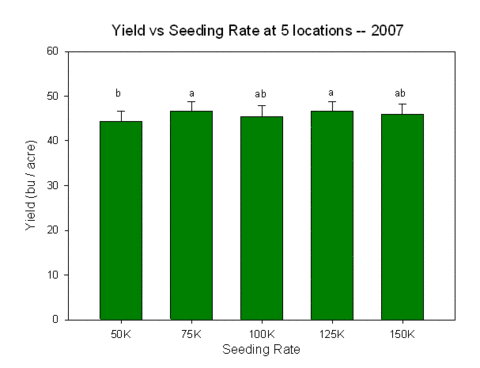While it’s essential that producers focus on maximizing yields, carefully managing inputs such as soybean seed will maximize profits.
Since 1998, weed control costs have been shifting more heavily onto the seed in the form of technology fees related to glyphosate resistance. Now soybean seed costs tend to be greater than soybean herbicide costs.
This has led many producers to consider reducing seeding rates.
The basics: Plant populations and yield
To fully understand our seeding rate recommendations, it’s important to grasp the underlying principles of populations and yield.
Soybean plant populations do not create yield, yet maximum yields require sufficient populations. Soybean stands must be large enough to maximize light interception throughout the growing season and provide abundant fruiting sites (leaf axils) to maximize the pod set.
More plants allow more potential places for seed to set and mature. For this reason, strive for the minimum plant stand at harvest to maximize yield.
Initial seeding rates help determine springtime stands, which help determine the number of plants that will ultimately bear seed and produce yield.
Years of studies related to hail injury taught us that soybean stands of 100,000 plants per acre or more at harvest are sufficient for maximizing soybean yields. While most of this research has been conducted in southern Minnesota and Iowa, it’s likely that this value is only slightly conservative for northern Minnesota producers.
Again, seeding rates only serve to establish this minimum stand. Increasing seeding rates provides returns only when stand establishment is poor.
Increased seeding rates can insure against poor stand establishment due to cold soils or crusting. However, when severe injury occurs (e.g., hail), small seeding rate increases rarely enable producers to avoid replanting.
The following factors affect final stands, which drive yield potential:
Seeding rate. With higher seeding rates, fall stands are reduced by a greater percentage due to inter-seed or inter-plant crowding. Wide rows with smaller inter-plant distances accentuate this effect.
Seed quality, as measured by standard germination, cold tests and/or accelerated aging test.
Soil type.
Soil conditions at planting and throughout emergence.
Stand establishment.
Late season growth.
Seeding equipment, which also plays a large role in determining emergence. Seeding equipment that poorly distributes the seed linearly (within the row) and/or vertically will lead to fewer plants at harvest relative to seed planted.
Research on seeding rates
Research by the University of Minnesota Extension confirmed earlier work that showed very low seeding rates under good conditions lead to maximum yields.
Research examined five seeding rates from 50,000 to 150,000 live seeds per acre (in 30-inch rows) in five southern Minnesota locations in 2007.
Only the lowest seeding rate (50,000) provided significantly lower yields than higher rates. Seeding at 75,000 live seeds per acre maximized soybean yield.
Row spacing
In a 12-site-year study, we found no interaction between row spacing and plant population. Narrow rows received no greater yield benefit from higher seeding rates than wide rows.
We did see a five bushel per acre increase when moving from 30-inch to 10-inch rows. We noted about half of this between 30- and 20-inch rows and half between 20- and 10-inch rows.
Acres with 22-inch rows should have about a two bushel advantage over 30-inch rows, but are probably at a two bushel disadvantage compared to 15-inch rows. Because we saw no interaction between row spacing and population, you don’t need to plant narrow-row soybeans at a higher rate than those planted in wide rows.
Other factors
Again, planter type will affect the seeding rate needed to achieve minimum required stands. Grain drills and air seeders require higher seeding rates, not because of their narrow row arrangement, but because they poorly distribute seed, both linearly and vertically.
Recommended seeding rates
Southern Minnesota
Under ideal conditions, plant southern Minnesota soybeans at about 140,000 live seeds per acre.
Central and northwestern Minnesota
In central and northwestern Minnesota, it appears that soybeans require harvest stands of 125,000 to 150,000 plants per acre to maximize yields. This is likely due to shorter-statured soybeans with fewer total nodes, which are often produced in these regions.
Thus, central and northwestern Minnesota require increased seeding rates. Below, we’re including recommendations based on soybean maturities to point producers toward reasonable soybean seeding rates.
Minnesota soybean seeding rate recommendations by maturity group
| Maturity group | Seeding rate |
|---|---|
| Group II soybeans | 140,000 live seeds per acre |
| Group I soybeans | 150,000 live seeds per acre |
| Group 0 soybeans | 160,000 live seeds per acre |
| Group 00 soybeans | 170,000 live seeds per acre |
Keep in mind our recommendations are:
-
Independent of row spacing.
-
Based on live seed. Carefully examine germ rates provided on seed tags.
-
Based on excellent to ideal planting conditions. Planting early or into cold and/or wet soils may require increased seeding rates. Seeding into heavy clay soils will likely require greater seeding rates compared to light or sandy soils.
Some additional cautions:
-
If you use planting equipment that poorly distributes the seed either linearly or vertically, you’ll need greater seeding rates. Likewise, planting at an excessive speed calls for greater seeding rates. High speeds decrease the precision of both linear and vertical seed placement.
-
If you plant in high pH areas prone to iron deficiency chlorosis (IDC), soybeans may benefit from higher seeding rates. This benefit amplifies when planting in wider rows (22 to 30 inches).
-
Use liberal seeding rates until you clearly understand how your planting equipment, planting date, soil type and spring conditions affect your actual plant populations. Due to the many variables affecting final stands, this requires taking stand counts in all fields each year. However, you’ll eventually fine-tune seeding rates, which reduces input costs while providing a sufficient plant population cushion to avoid replanting when Mother Nature does not cooperate.
Reviewed in 2018


